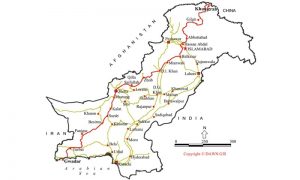Newspaper Article 30/06/2016
Historically, the very concept of a corridor, has been a cause of development in different parts of the world. In the post-1945 period, European Economic Community was formed (1957). Later, European Union (EU) was created in November 1993. The idea to establish Exclusive Economic Zones (EEZ) comprising Cambodia, Laos, Vietnam and Myanmar under the Greater Mekong Sub-region Economic Cooperation Programme is also akin to the concept of establishing economic corridor for promoting trade and people to people interaction.
The China-Pakistan Economic Corridor (CPEC) connecting Xingjian with Gwadar will generate economic activity, and benefit over three billion people in China, South Asia and Middle East. As stated by President Xi Jinping: “The China-Pakistan Economic Corridor is located where the Silk Road Economic Belt and the 21st Century Maritime Silk Road meet.” The four main pillars of CPEC are Gwadar port, communication infrastructure, energy infrastructure and industrial zones. The Special Economic Zones (SEZs) in the Pakistani port of Gwadar and Kashgar and the rail and road connectivity between proposed SEZs would develop great economic, political and strategic implications for the region. With the development of Gwadar Port, located at the Arabian sea (72 kilometres from Iran; about 320 kilometres from Cape al-Hadd in Oman and about 400 kilometres from the Strait of Hormuz and linked with Persian Gulf), all trade to and from Central Asian Republics (CARs) is going to adopt the shortest available route via Gwadar and the trade benefits to Pakistan are expected to multiply. China’s access to the markets of South Asia and Middle East would be enhanced (and would lessen the country’s dependence on the Strait of Malacca). The port of Shanghai is 10,000 kilometres from the Strait of Hormuz by sea via the Malacca route while Kashgar, the capital of Xinjiang, is about 4500 kilometres from the port of Shanghai. However, Kashgar is 2800 kilometres from Gwadar via the envisaged CPEC and hence just over 3400 kilometres from the Hormuz.
Major infrastructural projects to be constructed under the CPEC include Gwadar–Khunjerab Highway, Karachi–Lahore Motorway and Muzaffarabad–Mirpur Expressway. There are three routes of the CPEC. The first (Western) route suggests that the CPEC will enter Balochistan via Dera Ismail Khan to Zhob, Qila Saifullah, Quetta, Kalat, Punjgur, Turbet and Gwadar. The second (Central) route goes from Dera Ismail Khan to Dera Ghazi Khan and onwards to Dera Murad Jamali, Khuzdar, Punjgur, Turbet to Gwadar. The third route (Eastern) enters the Punjab province from Khyber Pakhtunkhwa, going through Lahore, Multan and Sukkur, from there it takes the traditional highway to enter Balochistan, passing through Khuzdar, Punjgur, Turbet and Gwadar. An alternate route will go from Sukkur to Karachi and from there take the coastal highway to Gwadar.
Out of US $ 46 billion economic package announced by China, US $ 34 billion have been allocated for energy projects. CPEC will ease Pakistan’s energy crisis. Federal Minister for Planning Development and Reforms, Ahsan Iqbal said: “The production of 10,000 megawatts of energy under the CPEC would help overcome the energy crisis by 2018 as well as upgrade the existing road network of the country.” Moreover, CPEC will enhance the foreign investor’s interest in Pakistan. According to data released by the State Bank of Pakistan, the country received US $ 975.4 million as FDI during July-March 2015/16 as compared with US $ 832.2 million in the corresponding period of last fiscal year. The FDI from China grew by 167 percent to US $ 516 million during July-March 2015/16 as compared to the US $ 193.3 million in the corresponding period of the last fiscal year.
Pakistan, located at the crossroads of resource rich Central and West Asia, the Persian Gulf and the oil rich Middle East holds a strategic position. With the implementation of CPEC, Pakistan could become a major world channel for petro-chemical trade. An international airport will be built at Gwadar with Chinese assistance. Universities are also being planned on CPEC Western route. These universities will educate and empower the people of FATA, Zhob and Gwadar. Tourism will flourish under CPEC. The province of Balochistan will become significant for regional integration. CPEC is a step towards regionalism. The corridor will constitute energy transfer, and accelerate the pace of economic development as well as regional connectivity. A well-integrated and economically vibrant South Asia will be in a better position to tackle problems of energy deficiency, poverty and terrorism.
Amna Ejaz Rafi
Assistant Research Officer, Islamabad Policy Research Institute (IPRI)
Disclaimer: Views expressed are of the writer and are not necessary reflective of IPRI policy.

